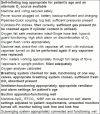Anaesthesia machine: checklist, hazards, scavenging
- PMID: 24249887
- PMCID: PMC3821271
- DOI: 10.4103/0019-5049.120151
Anaesthesia machine: checklist, hazards, scavenging
Abstract
From a simple pneumatic device of the early 20(th) century, the anaesthesia machine has evolved to incorporate various mechanical, electrical and electronic components to be more appropriately called anaesthesia workstation. Modern machines have overcome many drawbacks associated with the older machines. However, addition of several mechanical, electronic and electric components has contributed to recurrence of some of the older problems such as leak or obstruction attributable to newer gadgets and development of newer problems. No single checklist can satisfactorily test the integrity and safety of all existing anaesthesia machines due to their complex nature as well as variations in design among manufacturers. Human factors have contributed to greater complications than machine faults. Therefore, better understanding of the basics of anaesthesia machine and checking each component of the machine for proper functioning prior to use is essential to minimise these hazards. Clear documentation of regular and appropriate servicing of the anaesthesia machine, its components and their satisfactory functioning following servicing and repair is also equally important. Trace anaesthetic gases polluting the theatre atmosphere can have several adverse effects on the health of theatre personnel. Therefore, safe disposal of these gases away from the workplace with efficiently functioning scavenging system is necessary. Other ways of minimising atmospheric pollution such as gas delivery equipment with negligible leaks, low flow anaesthesia, minimal leak around the airway equipment (facemask, tracheal tube, laryngeal mask airway, etc.) more than 15 air changes/hour and total intravenous anaesthesia should also be considered.
Keywords: Anaesthesia machine; anaesthesia workstation; checklist; hazards; scavenging.
Conflict of interest statement
Figures
References
-
- Dorsch JA, Dorsch SE, editors. Understanding Anesthesia Equipment. 5th ed. Philadelphia, USA: Lippincott Williams and Wilkins; 2007. Hazards of anesthesia machines and breathing systems; pp. 373–403.
-
- Merchant R, Chartrand D, Dain S, Dobson G, Kurrek M, Lagacé A, et al. Guidelines to the practice of anesthesia revised edition 2013. Can J Anaesth. 2013;60:60–84. - PubMed
-
- Hartle A, Anderson E, Bythell V, Gemmell L, Jones H, McIvor D, et al. Checking anaesthetic equipment 2012: Association of anaesthetists of great Britain and Ireland. Anaesthesia. 2012;67:660–8. - PubMed
-
- Australian and New Zealand College of Anaesthetists. Recommendations on checking anaesthesia delivery systems, 4.2.3.4.2. 2003. [Last accessed on 2013 May 30]. Available from: http://www.anzca.edu.au/resources/professional-documents/ps31.html .
-
- Recommendations for Pre-Anesthesia Checkout Procedures. Sub-committee of ASA committee on equipment and facilities. 2008. [Last accessed on 2013 May 30]. Available from: http:// www.asahq.org/For-Members/Clinical-Information/2008-ASA- Recomme... .
Publication types
LinkOut - more resources
Full Text Sources
Other Literature Sources


